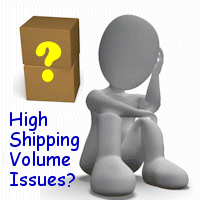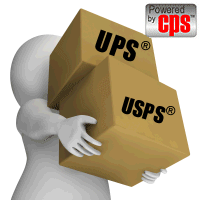Harvey Software’s CPS uses two carrier methods to process packages, giving CPS distinct advantages when processing high volumes of packages daily. This article will explain how these set CPS apart from other shipping systems.
Most multi-carrier shipping software on the market today use carrier provided API’s or Web Services to process packages. These work thru the Internet to communicate with carriers’ servers for each and every package, processed in real-time. It is like you are at the carrier’s shipping counter for each and every package.
These carrier tools are widely used by shipping software and online shipping systems on the market today. They are easily deployed and updated, with a lower cost to use and maintain. They can work well for many shippers.
Are there downsides to using these tools? Yes, there can be and these are experienced mostly by higher volume shippers or when the Internet connection has issues pop-up. If the Internet is up and running and the shipper is lucky enough to be in an area where consistently high Internet speeds are available, most companies experience acceptable package processing speeds. But many companies that sell shipping systems based on API or Web Services state their processing speeds based in a perfect Internet environment.
Let’s face it - there is no such thing as a perfect Internet environment all the time. Many times everyone is using the Internet all at the same time (like the critical seasonal shipping) and components of these totally Internet based shipping systems can go down. And down time in shipping is never good.
This is the reason that Harvey Software and a few other shipping software providers go to great expense to meet the carrier business rules that allow them to support carrier tools like UPS UPSLink (PLD) or USPS eVS for all packages processed through these carriers.
The advantage is in that both of these carrier services process each package locally throughout the day without needing real-time Internet data moving between the shipper and the carrier for each package. At the close out time, the shipper needs only to upload the carrier package data via the Internet in a single communication. Best of all, if this quick and simple communication fails for some reason, package shipping is never stopped and close outs can be done at a later time.
The challenge in supporting these direct, locally supported carrier services is that software developers have much more programming involved and meeting business requirements can be very costly. Every carrier change must be accounted for and be kept up-to-date. This is why our CPS software checks for carrier updates daily when it starts up and updates the local system in real time. This extra expense pays off in speed and system stability and is well worth the cost and effort.
The time saved during processing using this process is very noticeable. Compared to API or Web Services processing, with no Internet needed during the actual shipping process, there is no slowdown of critical package processing. This means high package volumes are shipped each day on a consistent basis, saving costs and increasing customer satisfaction.
With Harvey Software’s CPS products the shipper still can do all the other operations shippers do with the Internet based online carrier tools. This includes real-time rating, package processing, communicating package data between in-house systems, tracking, sending shipment notifications, and even support of custom carrier rates. Packages are processed faster and at a more consistent speed, which is very important for most shippers.
Speed and consistency are the start, but not all. For example, if a label is printed wrong or the shipping method needs to change, that process is also handled locally and fast. For USPS, there is no need to apply for refunds for printed postage or re-sending data to the carrier about the changes. When the shipper uploads carrier data at the end of the day, things like this have already been handled by the high volume shipping software, saving both the shipper and the carrier in post shipping billing costs.
More packages shipped per day also leads to lower labor costs, a decreased number of workstations needed to handle peak loads and more packages getting to customers daily.
This subject is not discussed much by shippers. With such potential advantages in shipping speeds and in the shipping process, we feel this subject deserves more attention and discussion. We welcome comments on this article and hope to learn more about the importance of this to your company by your comments.
For more information about why it makes sense to use high volume shipping software solutions in your business visit http://www.HarveySoft.com.
UPS® registered trademarks of United Parcel Service of America, Inc.
USPS® is a registered trademark of the United States Postal Service.




1 comment:
Before reading this post I don't know about shipping software solutions. And I was less aware of its importance and benefits. The company I am trusting for shipping my products is not offering me any software solution. Thank God I came to this post, I think choosing shipping company with software solutions will be more cost- effective for my business rather than choosing shipping company without software solution. At least I would not search for peace of mind.
Post a Comment